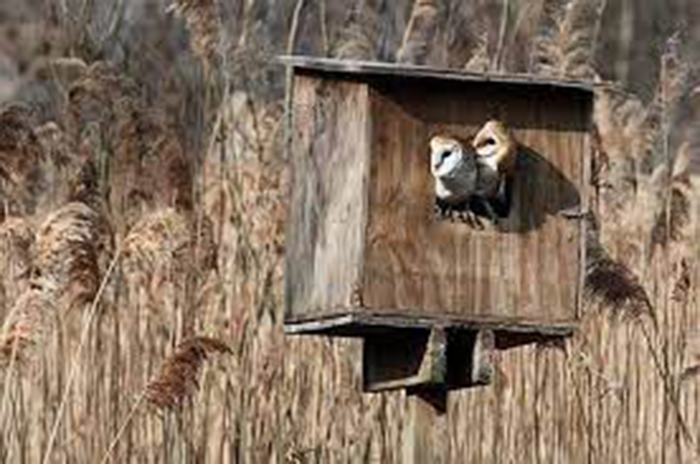Owls of Marin

Barn Owls
Photo Credit – Birds and Blooms
Someone from San Anselmo recently asked me about Owls in Marin, and expressed interest in installing an Owl Box. I believe Owl Boxes are available as part of the Hungry Owls Project sponsored by the WildCare organization in San Rafael, Marin County. Barn Owl Boxes and Screech Owl Boxes are available, and both types of owl are resident in Marin County, CA.

The most common owl in Marin County is the Great Horned Owl which breeds in the nests of other birds, such as raptors and covids, and is probably an unsuitable guest for Bird Boxes. They are one of the most common owls in North America, and are widely distributed across the continent and in parts of South America. The size of the owl makes it too large for most nest boxes, but there are other considerations. Great Horned Owls are fierce predators, and as well as eating squirrels and mice, they may attack housecats and small dogs. Their diet goes well beyond rodents. They may even attack humans while defending their territories. Even so, I spot them occasionally in my backyard, high in the conifer trees, displaying their horn-like tufts, and in the evenings and early mornings, I can hear their haunting hoots. Sometimes they are mobbed by cawing American crows because the Great Horned Owl is the crows’ most dangerous predator.
My dissertation on “European” Owls can be found in Chapter 18 of my novel She Wore a Yellow Dress, and the species most common to both this Bird Blog and that discourse, is the Barn Owl.
 Barn Owl Distribution
Barn Owl Distribution
Photo Credit – The Barn Owl Trust
Barn Owls are one of the most widely distributed birds in the world, and are found almost everywhere except in polar and desert areas and northern Asia. The species is nocturnal and specializes in hunting small mammals on the ground, especially rodents. It flies silently, and its call is a drawn-out screech. Sub-species of the Barn Owl live in different parts of the globe, and the bird is non-migratory. They nest in hollow trees, cliff cavities, barns and silos, and nest boxes, and long ago, one nested in the chimney of my Yorkshire home. The nest collapsed, the female dropped down the chimney into my brother’s bedroom, where it startled him and terrorized him until my parents caught and removed it.
Only the female sits on the nest, using the featherless area on her abdomen, known as the “brood patch”. Owls eat, but rarely drink. They obtain most of their water from their prey. Here in Marin it is believed that the population of the Barn Owl has declined in recent years because of the loss of nesting habitat and the effect of rat poison.

Marin County, and in particular, Point Reyes National Seashore, the Golden Gate National Park, and Muir Woods, are home to the Northern Spotted Owl. These are large owls, with rounded heads and no ear tufts. I have seen them on tree-tops in northern Point Reyes. They prosper in the northern coastal climate of California, and sometimes use nest boxes. It is suggested that their population has been supported by the presence of large numbers of dusky-footed woodrats, the owl’s preferred prey. You will note from the Range Map that there are three subspecies of Spotted Owl, each occupying a different geographic range.

However, not everything is stable for the Northern Spotted Owl. In 2002, their close relative, the Barred Owl, began to arrive in Marin County. This is an eastern species that has expanded its range westwards. Barred Owls are slightly larger than the Northern Spotted Owl, more aggressive, less choosy when selecting their prey, and may negatively affect the territory and nesting behavior of the Northern Spotted Owl. The two species look similar, except that the Northern Spotted Owl has a spotted brown and white pattern on its chest, while the Barred Owl has a barred brown and white pattern.

The Western Screech Owl may also occupy nest boxes, and has a presence in Marin County. It is a small, stocky owl, with conspicuous ear tufts, and tends to have a rufous plumage. It is doubtful that you will ever see this variety of owl. It is a nocturnal hunter and spends its daytime hiding in roost holes in trees. They include suburbia and public parks among their chosen habitats, and if you install an owl box, include a couple of inches of untreated wood shavings since the Western Screech Owl does not build its own nest. Also, beware of starlings that compete for the same roosting sites. Finally, if you hear one, it will sound like a set of whistled hoots, and not the screeching implied by the bird’s name.
Despite this article’s Marin County focus, it is not to say that there are no other species of owl found in California. There are several, with their own unique preferences for habitat. These include the Northern Pygmy Owl, Northern Saw-whet Owl, Flammulated (flame-colored) Owl, Burrowing Owl, the Great Gray Owl, the Short-eared and Long-eared Owls, and the rare Snowy Owl.
The Northern Pygmy Owl is about the size of a sparrow, hunts during the daytime, is generally non-migratory, has a rapid high-pitched staccato call, and nests in tree cavities and woodpecker holes. The Northern Saw-whet Owl (possibly named after its saw-like call), sometimes migrates, and inhabits dense forests in the central and southern United States. The Flammulated Owl, about the size of an American Robin, migrates to Mexico and Central America after breeding in eastern parts of California and other south-west States. Unlike other owls, it feeds on insects.
Today, the Burrowing Owl is found mainly in California’s Imperial Valley, although decades ago, it was more widespread, and included a breeding population in Marin County. It lives underground in burrows that it digs itself.
The Great Gray Owl is a large owl that avoids people, is a permanent resident of coniferous forests, hunts at night, and in California, its range is restricted to the north-eastern part of the State.
Long-eared Owls are occasional winter visitors and have been spotted in Marin County. Historically, they likely bred in this County. They are medium-sized, have long ear tufts that are held erect, and are rarely seen because in the daytime they hide in trees, and at night, they hunt in open areas. Short-eared Owls are rare and declining in number in California. They are recognized as a species of special concern because of loss of habitat. The species is ground-nesting, and prefers grassland and marshland such as that found in north-eastern California and the Central Valley. During winter, a few may appear along parts of the California coast.
Hopefully, now that you know something about California owls, you will choose to advocate for these birds in your part of the State, possibly exempting yourself from invasive species such as the Barred Owl.
POSTSCRIPT: And it would be remiss of me not to mention a large owl species that is dominanly white with mottled plumage, and very rare in California, the Snowy Owl. Their presence here is highly unusual, although one last year made it as far south as Los Angeles County. They breed in the Arctic tundra and some move south for winter, occasionally reaching Central California. Unlike most owl species, they hunt during the daytime, as well as at night.










This information is perfect! It is a thorough evaluation of owls in Marin. I will get in touch with the Hungry Owls Project and look forward to having an owl box here as soon as possible.
Many thanks for the information!!
I sent you an email recently, and I’m looking to make.my owl box inhabitants, hope you can help, thanks.